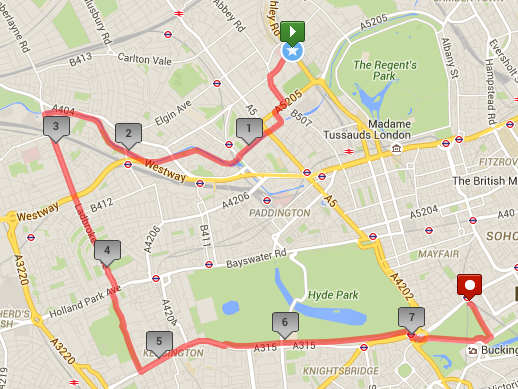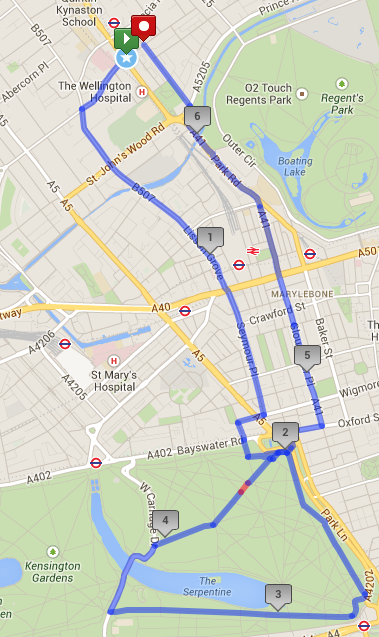Hi Everyone,
Rain, cold, sun…Just another week in London! Thanks for getting out and running in all sorts of weather.
This is a bit of a long email, but it’s filled with very important training information so please read it! On Monday we have an 8-mile run out the canal west, through Notting Hill and Holland Park, down Kensington High Street to Hyde Park and ending at Green Park. Remember to watch your pace (more on that below).
Wednesday we’re doing another new tempo/speed workout and this time we’re in Hyde Park. Make sure you read the directions in the route section. As always, these workouts are so much more fun if you stick together as a group and encourage each other along the way. Friday we’re back up the Hill!
Our mileage is increasing! Make sure you take care of yourself. Stretch. Hydrate. Rest. See a specialist if something is bothering you. Schedule a sports massage. The Expert Help section on the Training tab on our website has a list of people who can help. Also don’t over do it. If you are thinking about doing the HIIT Lululemon class on Tuesday, you probably can’t also do an intense speed workout on Wednesday. Listen to your body!
Training Plan
As a reminder, our training is based on three runs per week.
- slow, longer run
- faster/tempo run
- hill run
This week I’d like to focus on the importance of running a slower long run. Below I’ve copied Paula Mitchell’s (WRW’s fabulous founder!) explanation from our website. This is important stuff so it’s worth the read.
Why do we run the long run slower than race pace?
The quick answer is that it has to do with how your body builds fuel, which is something you’ll need for the race! I’ll delve into the basic science of fueling (which I have hugely over-simplified but hopefully it’ll get my point across). To fuel our runs we have 3 options – Creatine Phosphate (CP), glycogen and fat.
Creatine Phosphate– You have about 15 seconds worth of CP fuel – that’s it. Think Usain Bolt running the 100m – he fuels with CP and it works because he can run 100m in less than 15 seconds. CP is where your body will go first looking for fuel, particularly if you take off like a rocket from Starbucks. Think of CP as kindling on a fire – it catches fire easily, but burns out very quickly.
Glycogen– Glycogen is the next fuel option. Glycogen is basically stored in your muscles and in your liver and because of that it makes glycogen a bit more difficult to burn as fuel (think of damp firewood – it will eventually burn, but it takes quite a bit to get it going).
Fat– Fat is the 3rd source of fuel and most runners, even the very lean women, have an ample supply of it. Think of fat as a butane tank of gas on the BBQ grill – once it’s lit, you can have countless cook-outs before the fuel is gone.
Here’s the important part- All of those fuel sources – kindling, damp firewood or butane gas need something to ignite them and keep them burning. Physiologically speaking that ignition or burning “tool” is ATP which is created by mitochondria; so, the more mitochondria you have the more efficient you are as a fuel burning machine.
What is mitochondria and how do we get more of it? Some of us are genetically blessed with higher mitochondria counts. Thank your mother for that – it comes through the maternal side of the genetic equation. If you didn’t win the genetic lottery, then the only way you can increase mitochondria is through LONG, SLOW, ENDURANCE training (LSE). When you go for a long run at a slow pace, you actually produce mitochondria. Kind of cool, huh? Now remember – we need mitochondria to help ignite our fuel sources. So what does that mean for you? It means SLOW DOWN on your long run – give your body a chance to become a mitochondria production factory. If you do your long run at a strong pace, you’re missing out on this benefit.
How slow, is slow? On our website we have a cool calculator from Runners World that calculates training pace based on your race pace. LINK (It has 6 different training paces for speed work, training and longer runs.) If you would like to run the half marathon in 2 hours (which is a fast time) you will need to average 9:10 min/mile during the race, but your long run pace should be 10:34-11:54. If you would like to run it in 2 hours and 15 minutes, you will need to run 10:15 min/mile during the race but your long run pace should be 11:46-13:12. If you want to run it in 1 hour and 45 minutes (we will only have a few women at that pace from our group) you will average an 8 min/mile race pace but should do your long run at 9:20-10:30. I think you get the general picture. I imagine that these times seem much different than your usual Monday pace! The message is that you need to slow down a bit especially now that we are at the point in our training when we are doing our longest runs.
But I don’t know my race time? That’s fine. Talk to the women in your pace group. Many of them will have run a half marathon before and you can get a sense of their race time as a base for what you might target as a race time. During training, if you don’t have a pace watch, ask the women in your pace group so you can get a general sense of the speed of the group. Also, try slowing down to the lower end of your pace group time. As a rule of thumb, your long run should be at a pace so comfortable that you feel like you could run forever.
It feels like this shouldn’t work. I know it seems counter intuitive. (I want to run a fast race so I train slowly. Really?) Trust us on this one. We’ve had very sceptical runners who followed this program and ran great races. It does work. Also, don’t forget we’ll be adding more tempo and speed work into our workouts, just not on the long run day.
High Intensity Training Class by Lululemon – Tuesday 24 January
Thanks to Stephanie Gladis and Kathy Anderson who have arranged a HIIT class (high intensity interval training) for the SJW Women’s Club and they have extended the invitation to WRW as well. The class is designed by Lululemon ambassador Lawrence Hannah and is the most effective and efficient way to improve fitness, torch fat, and increase your cardio. Get ready for short periods of intense work followed by short periods of rest which will boost your strength and cut your running times. Your body will work so hard it’ll create an “afterburn effect,” which means you’ll continue to burn fat hours after our workout has finished. You’ll also learn proper technique and exercise that can be done without weights and gym using just your bodyweight. We’ll head back to Lululemon for a stretch and maybe a surprise or two.
Meet at 8:45am at the Lululemon Marylebone store (74-75 Marylebone High Street, W1U 5JW).
Sign-ups are through the SJWWC website, and if you aren’t a member, just email Stephanie Gladis or Kathy Anderson
Save the Date – Tuesday January 31 – Shirt/Hat Distribution and Money Collection
On Tuesday January 31 in the morning, we’ll be collecting money and distributing the WRW shirts and hats. (They look amazing!) We will also be collecting money for certain expenses for the Warsaw Half Marathon trip. More details to follow.
Thanks for reading that long email! And keep running!
Jane
ROUTES
Monday, 23 January – Holland Park to Green Park (8 miles)
We start out the same as our traditional Notting Hill Route [Circus Rd to Grove End, to St Johns Wood Rd to Cunningham, to Blomfield to the Canal, going west past the Westway to Ladbroke Grove]. Once on Ladbroke Grove, run south all the way until it ends at Holland Park Avenue. Cross Holland Park Avenue, take a right and then a left on Holland Walk [just past Aubrey Road]. Holland Walk is a pedestrian way. Run up Holland Walk until the first entrance into Holland Park on your right [opposite the Duchess of Bedford Walk]. Run into the park and then turn left on the broad walk which goes the length of Holland Park until it ends at Kensington High Street; turn left and run along Ken High Street. (For a shorter run, you can leave at the Ken High St Tube which makes it about a 5 mi run). Otherwise, continue on until you reach Kensington Park, where you enter it at the junction with the Broad Walk [just before Palace Gate road]. Take the Broad Walk to the first path on the right which turns into So Carriage Dr. You’ll run past The Albert Memorial and cross West Carriage Dr at the light. Continue on So Carriage Dr all the way to Apsley House/Hyde Park Corner. Cross over Piccadilly and run under Wellington Arch, then cross at the light to run along the path to the left of Constitution Hill [the same route we take in going to Big Ben], At the Mall, turn left to run to the easternmost path of Green Park [again, familiar from other routes], turn left and run by Lancaster House to Green Park Tube. Hop on the Tube back to SJW and meet up at Starbucks

Wednesday, 25 January – Hyde Park Tempo Triangle
Head down to Hyde Park the usual way at a very gentle pace. Once you reach the park pick up the pace a bit around Speaker’s Corner, and then run very fast down to the SE corner of the park. Jog slowly around the corner while you try to bring your heart rate back down to a recovered rate. Once you reach the straightaway, run hard again to Carriage Road. Slow down to a recover rate again as you cross over the bridge and up to the path, where you will turn right and run hard along the diagonal back to Speaker’s Corner. Jog very slowly back to SJW or, even better, hop on the bus or tube from Marble Arch. If you are not doing tempo work, you can do this run at a regular pace (if you go back to SJW it is about 6.5 miles).

Friday, 27 January – The Heath!
It’s Friday [again!], so everyone up the hill! You can pick your distance and whatever you choose, there will certainly be someone else interested in running that distance. All of these routes are on the website. If you are not up for a hill run, ask around at Barclays; every week there is a group who prefer to do a flat run and you can decide together which flat route to tackle.
4 miles: A great way to ease into running the hill. Run up to the Hampstead tube station and back. If you have trouble running up, think about how easy it will be running down!
5 miles: The Betsy Route
6+ miles: The Partial Heath route OR the Reverse Heath route
7.5 miles: The Highgate route
8 miles: The Full Heath route
Click here for maps of all of the Heath routes.
